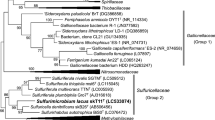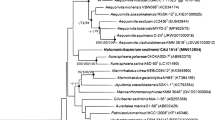Abstract
A new rod-shaped, gram-negative, non-sporeforming, strictly anaerobic bacterium (strain HHQ7) was enriched and isolated from marine mud samples with hydroxyhydroquinone (1,2,4-trihydroxybenzene) as sole substrate. Strain HHQ7 fermented hydroxyhydroquinone, pyrogallol (1,2,3-trihydroxybenzene), phloroglucinol (1,3,5-trihydroxybenzene) and gallic acid (3,4,5-trihydroxybenzoate) to 3 mol acetate (plus 1 mol CO2 in the case of gallic acid) per mol of substrate. Resorcinol accumulated intermediately during growth on hydroxy-hydroquinone. No other aliphatic or aromatic substrates were utilized. Sulfate, sulfite, sulfur, nitrate, and fumarate were not reduced with hydroxyhydroquinone as electron donor. The strain grew in sulfide-reduced mineral medium supplemented with 7 vitamins. The DNA base ratio was 59% G+C. Strain HHQ7 is classified as a new species of the genus Pelobacter, P. massiliensis. Experiments with dense cell suspensions of hydroxyhydroquinone-and pyrogallol-grown cells showed different kinetics of hydroxyhydroquinone and pyrogallol degradation, as well as different patterns of resorcinol accumulation, indicating that these substrates are metabolized by different transhydroxylation reactions.
Similar content being viewed by others
References
Beyer H, Walter W (1988) Lehrbuch der organischen Chemie, 21th edn. Hirzel, Stuttgart, FRG
Bradford MM (1976) A rapid and sensitive method for the quantitation of microgram quantities of protein utilizing the principle of protein-dye binding. Anal Biochem 72: 248–254
Brune A, Schink B (1990) Pyrogallol-to-phloroglucinol conversion and other hydroxyl-transfer reactions catalyzed by cell extracts of Pelobacter acidigallici. J Bacteriol172: 1070–1076
Cimino G, De Stefano S, Minale L (1974) Occurrence of hydroxyhydroquinone and 2-aminoimidazole in sponges. Comp Biochem Physiol 47B: 895–897
Cord-Ruwisch R (1985) A quick method for the determination of dissolved and precipitated sulfides in cultures of sulfate-reducting bacteria. J Microbiol Methods 4: 33–36
Dehning I, Stieb M, Schink B (1989) Sporomusa malonica sp. nov., a homoacetogenic bacterium growing by decarboxylation of malonate or succinate. Arch Microbiol 151: 421–426
Evans CW (1977) Biochemistry of the bacterial catabolism of aromatic compounds in anaerobic environments. Nature 270: 17–22
Krumholz LR, Crawford RL, Hemling ME, Bryant MP (1987) Metabolism of gallate and phloroglucinol in Eubacterium oxidoreducens via 3-hydroxy-5-oxohexanoate. J Bacteriol 169: 1886–1890
Magee CM, Rodeheaver G, Edgerton MT, Edlich RF (1975) A more reliable Gram staining technique for diagnosis of surgical infections. Am J Surg 130: 341–346
Marmur J and Doty P (1962) Determination of the base composition of deoxyribonucleic acid from its terminal denaturation temperature. J Mol Biol 5: 109–118
Patel TR, Hameed N, Martin AM (1990) Initial steps of phloroglucinol metabolism in Penicillium simplicissiumum. Arch Microbiol 153: 438–443
Prochàzkovà L (1959) Bestimmung der Nitrate im Waser. Z Anal Chem 167: 254–260
Samain E, Albagnac G, Dubourguier HC (1986) Initial steps of catabolism of trihydroxybenzenes in Pelobacter acidigallici. Arch Microbiol 144: 242–244
Walker JRL, Taylor BG (1983) Metabolism of phloroglucinol by Fusarium solani. Arch Microbiol 134: 123–126
Widdel F (1980) Anaerober Abbau von Fettsäuren und Benzoesäure durch neu isolierte Arten Sulfat-reduzierender Bakterien. PhD thesis, Göttingen, FRG
Widdel F (1986) Growth of methanogenic bacteria in pure culture with 2-propanol and other alcohols as hydrogen donors. Appl Environ Microbiol 51: 1056–1062
Widdel F, Pfennig N (1981) Studies on dissimilatory sulfate-reducting bacteria that decompose fatty acids. I. Isolation of new sulfate-reducing bacteria enriched with acetate from saline environments. Description of Desulfobacter postgatei gen. nov., sp. nov. Arch Microbiol 129: 395–400
Widdel F, Pfennig N (1984) Dissimilatory sulfate- or sulfur-reducing bacteria. In: Krieg NR, Holt JG (eds) Bergey's manual of systematic bacteriology, IXth edn., vol. 1. Williams & Wilkins, Baltimore London, pp 663–679
Wratten SJ, Meinwald J (1981) Antimicrobial metabolites of marine sponge Axinella polycapella. Experientia 37: 13–14
Young LY, Frazer AC (1987) The fate of lignin and lignin-derived compounds in anaerobic environments. Geomicrobiol J 5: 261–293
Author information
Authors and Affiliations
Rights and permissions
About this article
Cite this article
Schnell, S., Brune, A. & Schink, B. Degradation of hydroxyhydroquinone by the strictly anaerobic fermenting bacterium Pelobacter massiliensis sp. nov.. Arch. Microbiol. 155, 511–516 (1991). https://doi.org/10.1007/BF00244971
Received:
Accepted:
Issue Date:
DOI: https://doi.org/10.1007/BF00244971




